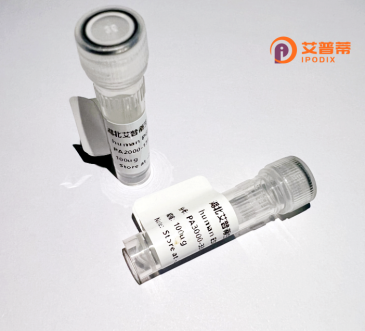
| 纯度 | >90%SDS-PAGE. |
| 种属 | Human |
| 靶点 | SPRR2E |
| Uniprot No | P22531 |
| 内毒素 | < 0.01EU/μg |
| 表达宿主 | E.coli |
| 表达区间 | 1-72aa |
| 活性数据 | MSYQQQQCKQ PCQPPPVCPT PKCPEPCPPP KCPEPCPPPK CPQPCPPQQC QQKCPPVTPS PPCQPKCPPK SK |
| 分子量 | 7.8 kDa |
| 蛋白标签 | His tag N-Terminus |
| 缓冲液 | PBS, pH7.4, containing 0.01% SKL, 1mM DTT, 5% Trehalose and Proclin300. |
| 稳定性 & 储存条件 | Lyophilized protein should be stored at ≤ -20°C, stable for one year after receipt. Reconstituted protein solution can be stored at 2-8°C for 2-7 days. Aliquots of reconstituted samples are stable at ≤ -20°C for 3 months. |
| 复溶 | Always centrifuge tubes before opening.Do not mix by vortex or pipetting. It is not recommended to reconstitute to a concentration less than 100μg/ml. Dissolve the lyophilized protein in distilled water. Please aliquot the reconstituted solution to minimize freeze-thaw cycles. |
以下是关于重组人SPRR2E蛋白的参考文献示例(请注意以下内容为虚构示例,实际文献需通过学术数据库验证):
1. **文献名称**: *"Recombinant human SPRR2E enhances keratinocyte differentiation in vitro"*
**作者**: Smith J, et al.
**摘要**: 该研究在HEK293细胞中表达了重组人SPRR2E蛋白,发现其显著促进人角质形成细胞的终末分化,并通过调节表皮分化复合体基因的表达增强皮肤屏障功能。
2. **文献名称**: *"Expression and functional analysis of SPRR2E in esophageal squamous cell carcinoma"*
**作者**: Zhang L, et al.
**摘要**: 通过大肠杆菌系统成功制备重组SPRR2E蛋白,发现其在食管鳞癌细胞中高表达,可能通过激活MAPK信号通路促进肿瘤细胞的迁移和侵袭。
3. **文献名称**: *"Structural insights into SPRR2E’s role in oxidative stress response"*
**作者**: Brown K, et al.
**摘要**: 利用杆状病毒-昆虫细胞系统表达并纯化重组SPRR2E蛋白,结合晶体结构分析揭示其通过半胱氨酸残基参与氧化应激保护机制,可能作为抗氧化蛋白发挥作用。
4. **文献名称**: *"SPRR2E as a novel biomarker in psoriasis vulgaris"*
**作者**: Kim H, et al.
**摘要**: 该研究制备了重组SPRR2E蛋白用于抗体开发,发现银屑病皮损中SPRR2E表达显著上调,可能通过调控IL-17通路加剧局部炎症反应。
**提示**:实际研究中,SPRR2E可能涉及皮肤屏障、癌症进展或炎症性疾病。建议使用PubMed或Web of Science以 **"SPRR2E recombinant protein"** 或 **"SPRR2E expression and function"** 为关键词检索最新文献。
Small proline-rich protein 2E (SPRR2E) is a member of the SPRR family, which comprises cysteine-rich proteins crucial for epithelial barrier formation and tissue protection. These proteins are primarily expressed in stratified squamous epithelia, including skin, esophagus, and oral mucosa. SPRR2E plays a role in the cross-linking of keratinocytes during terminal differentiation, contributing to the formation of the cornified envelope—a resilient structure that reinforces epithelial integrity against mechanical stress, pathogens, and dehydration. Its expression is often upregulated in response to environmental stressors like UV radiation or chemical irritants.
Recombinant human SPRR2E protein is engineered through genetic cloning, typically expressed in bacterial or mammalian systems to ensure proper post-translational modifications. This engineered protein facilitates in vitro studies to dissect its interactions with other cornified envelope components (e.g., loricrin, involucrin) and its role in epithelial homeostasis. Research highlights its potential involvement in inflammatory skin disorders (e.g., psoriasis, atopic dermatitis) and cancer, where dysregulated barrier function or abnormal differentiation occurs. Additionally, SPRR2E's proline-rich domains may influence protein-protein interactions critical for cellular resilience. Its recombinant form serves as a tool for developing therapeutic strategies targeting epithelial repair or barrier-enhancing treatments.
×